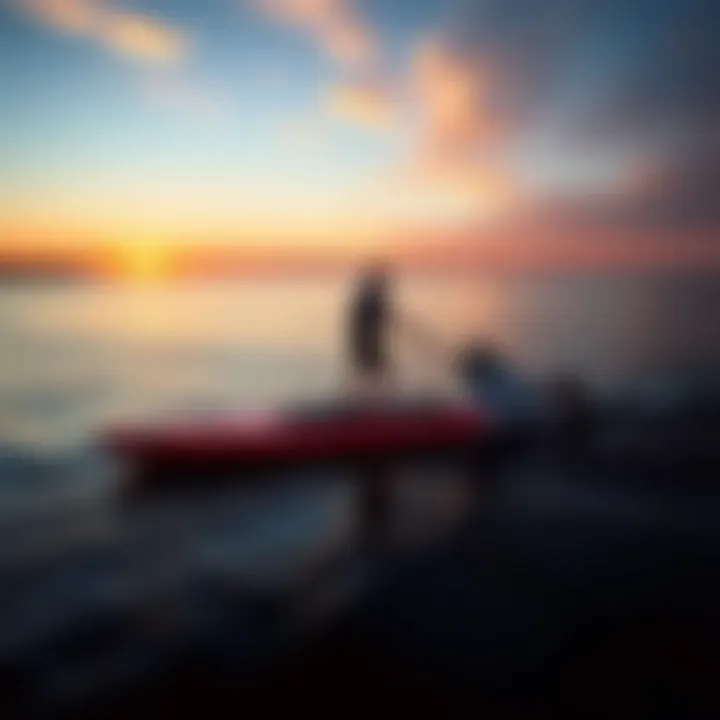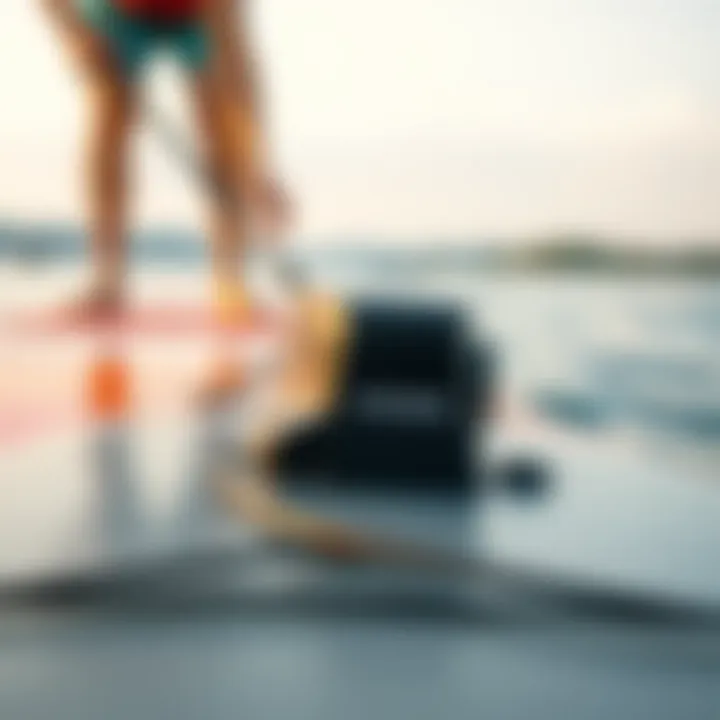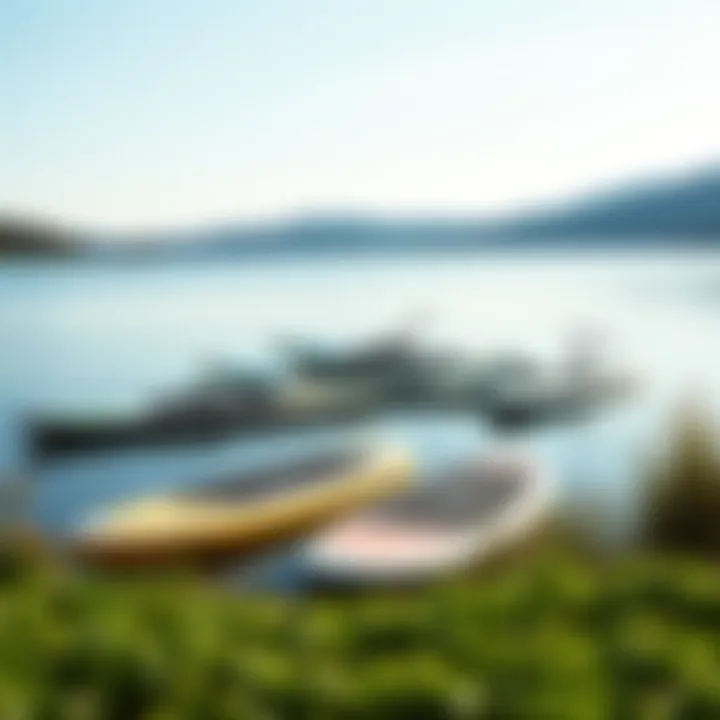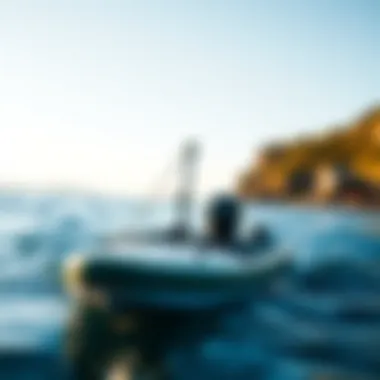Exploring Motorized Paddleboards: Features and Benefits


Intro
Motorized paddleboards are carving their own niche in the watersports industry, transforming how enthusiasts engage with water adventures. With the curious blend of traditional paddleboarding's tranquility and the thrill of motor propulsion, these boards are changing the game for both beginners and seasoned paddlers. In a world where convenience often reigns supreme, the rise of this innovative watercraft reflects the desire for exploration coupled with accessibility.
Unlike their non-motorized cousins, motorized paddleboards offer an effortless glide across lakes, rivers, and even coastal waters. This article dives into the multifaceted world of motorized paddleboards, discussing their unique designs, technological advancements, safety measures, and environmental impacts. Whether you're a seasoned athlete looking to enhance your repertoire or a newcomer eager to embrace this modern marvel, there’s always something new to discover.
By grasping the intricacies involved—from the technology that powers these boards to practical tips for safe and eco-friendly enjoyment—you'll gain comprehensive insights that elevate your experience. Join us as we unlock the various aspects of motorized paddle boarding, ensuring you're well-prepared for your next aquatic adventure.
Prolusion to Motorized Paddleboards
The rise of motorized paddleboards is reshaping the watersport landscape. These boards, equipped with engines, enhance the experience of gliding across serene lakes or navigating choppy ocean waves. As more adventurers discover the thrill of powered paddling, understanding these innovations becomes crucial. This guide looks to illuminate various facets of motorized paddleboards, catering especially to athletes, coaches, and recreationists who seek both performance and leisure in their water activities.
Motorized paddleboards combine the essence of traditional paddling with modern technology, enabling users to cover greater distances without the exhaustive physical effort required by conventional methods. They provide a wonderful avenue for exploring the great outdoors, offering versatility for different water bodies. While typical paddleboards may require considerable physical fitness and skill, motorized versions are often more accessible, allowing beginners and those with mobility challenges to participate fully in water sports.
This section will unpack the finer details of what sets motorized paddleboards apart, diving into their definition and tracing their historical development.
Defining Motorized Paddleboards
Motorized paddleboards, often referred to as e-boards, are defined by their unique blend of buoyancy and propulsion. Unlike traditional paddleboards that rely solely on human strength, these boards feature an integrated motor that facilitates movement. The motor allows users to accelerate and maintain speed with ease, making it a practical choice for enthusiasts wanting an effortless glide over water.
These boards often include features like adjustable speeds and battery-operated propulsion, catering to various skill levels. With the innovation in the paddleboarding field, manufacturers have moved beyond simple motors to create sophisticated systems that enhance performance and user experience.
Historical Context and Evolution
The concept of powered watercraft isn't new, stemming back to primitive motorboats. However, the transition from traditional kayaking and surfing to motorized paddleboarding began gaining ground in the early 2000s. Fast forward to today, what started as a niche hobby has burgeoned into a thriving segment of the water sports market.
In the early years, motorized paddling was often viewed as an inferior option to traditional paddling, perceived as lacking the challenge and connection to nature that many enthusiasts cherish. However, as technology improved, so did the capabilities and designs of these boards. They became lighter, more durable, and equipped with features that not only preserved the essence of paddling but enhanced it.
The shift in public perception has also been aided by the boards’ ability to include innovative tech, such as GPS tracking, Bluetooth connectivity, and user-friendly interfaces. Many adventurers now see motorized paddleboarding as a fresh frontier, bridging the gap between leisure and exploration.
As we delve deeper into the nuts and bolts of motorized paddleboards, from design elements to safety, there’s much to unearth for enthusiasts of all stripes. Understanding this evolution allows users not only to appreciate their boards but to utilize them more effectively in their outdoor escapades.
Design Elements of Motorized Paddleboards
Design elements of motorized paddleboards play a pivotal role in defining their performance and usability, drawing enthusiasts who seek a blend of adventure and ease. A thorough understanding of these design components is not just important for manufacturers and designers, but they are equally relevant for athletes, coaches, and recreationists aiming to make the most out of their water activities. The design intricacies impact speed, stability, and overall user experience, laying the foundations for safe and enjoyable outings on the water.
Anatomy of a Motorized Paddleboard
The anatomy of a motorized paddleboard consists of several critical components, each tailored to enhance the overall efficiency and comfort of the ride. At first glance, the hull stands out; it's typically wider and thicker than traditional boards, which improves stability, particularly at higher speeds. The hull can vary in shape: some boast a pointed nose for cutting through water more efficiently, while others have a rounded shape providing better balance.
Next, we cannot overlook the motor itself. Usually mounted at the rear, motors like brushless DC can achieve speeds of up to 20 mph or more, depending on the board's design. This enables users to cover larger distances with less exertion, which can be a game-changer when exploring expansive water bodies.
Batteries are another aspect of anatomy worth mentioning. Their positioning can affect weight distribution. A well-placed battery ensures stability and enhances maneuverability. Not to forget, the control deck where users manage speed and direction; easy access and ergonomic design make a significant difference in handling.
Construction Materials and Durability
When it come to construction materials, durability is key. Most motorized paddleboards are made from high-density polyethylene or fiberglass. High-density polyethylene is robust and resilient, making it ideal for rough conditions. However, fiberglass offers a lighter alternative, often preferred for its performance characteristics in gleam conditions. Composite materials are also gaining traction due to their enhanced properties, offering a balance of weight and strength.
Moreover, some boards feature an anti-slip deck which not only adheres to safety standards but also improves user experience. Durability doesn’t just stop at material choice; the sealants used can prevent water incursion, prolonging the board's life. In essence, the thoughtful selection of materials results in products that withstand wear and tear while ensuring a terrific boarding experience.
Weight and Portability Considerations
Weight considerations in motorized paddleboards cannot be stressed enough. Heavier boards may offer a stable ride but can be cumbersome to transport. On the flip side, lightweight models facilitate easy handling, especially for those who may not have a strong build. It’s wise to check specs for the maximum load, as exceeding this can severely impact performance.
Portability features such as removable fins and compact sizes when deflated can make a world of difference. Many manufacturers are incorporating features that cater to easy storage and transport, which is a boon for individuals who wish to paddle in multiple locations without hassle.
"A well-designed paddleboard is like a trusted friend on the water, guiding you towards uncharted adventures and memorable experiences."
By leveraging this knowledge, athletes, coaches, and recreationists can enhance their water excursions while embracing the unique attributes that motorized paddleboards have to offer.


Technology Behind Motorized Paddleboards
The realm of motorized paddleboards stands at the cutting edge of watercraft innovation, where technology plays a pivotal role. Understanding the mechanics and features that drive these boards not only enhances user experience but also opens up opportunities for efficiency and adventure on the water. The combination of engineering prowess and user-centric designs makes these boards a noteworthy subject.
Motor Types and Performance Metrics
At the heart of any motorized paddleboard lies its motor type, which directly influences its performance. Generally, there are two main categories of motors found in these paddleboards: brushless motors and brush motors.
- Brushless Motors: These motors are favored for their efficiency and longevity. They generate less heat and require less maintenance compared to their brushed counterparts. The power delivery is smoother, translating to quieter rides, which can be a significant advantage in wildlife-rich areas. Common performance metrics for these motors include power output (measured in watts), rotational speed (RPM), and torque, which are pivotal for determining speed and handling.
- Brush Motors: While generally less efficient than brushless motors, they can still deliver impressive performance at a lower cost. They are typically heavier and require more maintenance, but their simplicity makes them attractive for budget-conscious users.
The choice of motor impacts not only speed but also thrust, enabling paddleboards to navigate through various water conditions easily. Average speeds can range from 4 to 10 mph depending on the motor type and conditions, but savvy users can push these limits with the right configurations.
Battery Life and Charging Solutions
Battery life is another crucial aspect when it comes to motorized paddleboards. The energy source determines how long you’ll enjoy your time on the water. Motorized boards predominantly utilize lithium-ion batteries due to their high energy density and lightweight nature.
- Charging Solutions: Most paddleboards come with charging options that are user-friendly. Some boards feature adaptive chargers that can optimize charging times based on the battery’s condition. Standard charging might take anywhere from 2 to 6 hours, but fast-charging technologies are becoming more common, reducing downtime significantly.
- Battery Management Systems (BMS) are essential tools, monitoring voltage and temperature to safeguard against overcharging and maintain battery health. Regular maintenance checks can extend battery life and ensure peak performance.
"Choosing the right battery and understanding charging solutions can greatly enhance your paddleboarding experience and time efficiency on the water."
Control Mechanisms and User Interfaces
Navigating the water with a motorized paddleboard could be an exhilarating experience, and that experience is significantly impacted by the control mechanisms and user interfaces. Modern paddleboards are equipped with intuitive controls that allow users to concentrate on maneuverability rather than worrying about the mechanics.
- Remote Controls: Many motorized boards come with wireless remote controls that let you manage speed and direction effortlessly. This is particularly vital for beginners who may not be confident with handling power. Adjustments can be made at the touch of a button, enabling a seamless transition between cruising and stopping.
- Smartphone Integration: Some models also offer smartphone applications that can connect to the board, providing features like performance tracking, battery life monitoring, and even navigation assistance. Imagine glancing at your phone and knowing just how much juice you have left, or if a nearby checkpoint is worth exploring.
As technology advances, we might see more sophisticated HUD (Heads-Up Display) systems that provide real-time data, helping paddlers make informed decisions instantly.
In summary, the interplay of motor types, battery solutions, and control mechanisms creates a symphony of efficiency and innovation in motorized paddleboards. As users embrace these technologies, the potential for unique experiences on the water continues to grow.
Advantages of Motorized Paddleboards
Motorized paddleboards represent a significant shift in how we engage with water sports. This section delves into several key advantages that these innovative boards offer, setting them apart from traditional paddleboards. As the interest in water recreation continues to grow, understanding these benefits is essential for both new enthusiasts and seasoned paddlers alike.
Enhanced Speed and Efficiency
One of the most noticeable benefits of motorized paddleboards is their ability to travel faster than non-motorized options. Traditional paddleboarding relies heavily on human strength and stamina, which can lead to slower speeds, especially over longer distances. With the addition of a motor, paddlers can achieve impressive speeds, turning what once required hours of effort into a more efficient experience. This is particularly advantageous for journeys across larger bodies of water or during windy conditions.
Moreover, the motorized boards have a higher efficiency in terms of energy use. Most models are designed with hydrodynamics in mind, allowing for smooth gliding through water. As a result, riders can cover more ground while using less energy, which is crucial for both leisurely outings and exploratory adventures.
Accessibility for Beginners and the Physically Challenged
Motorized paddleboards break down barriers, making the sport more inclusive. Beginners often face challenges when starting, particularly with balance and paddling techniques. However, a motorized option allows newcomers to enjoy the water without the steep learning curve associated with traditional paddleboarding. They can focus on enjoying the experience rather than struggling with technique.
For individuals with physical challenges, motorized paddleboards provide a way to partake in aquatic activities that may otherwise be inaccessible. The use of a motor significantly reduces the physical demands of paddling, allowing those with limited mobility to enjoy waterscapes that were once off-limits. Adaptations can also be made to various models to cater to specific physical needs, promoting inclusivity in the sport.
Exploration of Diverse Water Bodies
The versatility of motorized paddleboards opens up a plethora of opportunities for exploration. Unlike traditional boards that may be limited to calm lakes or rivers, motorized versions can navigate through rougher waters, such as coastal areas or choppy seas. This opens up new adventures for riders, enabling them to traverse diverse landscapes.
With a reliable motor underneath, paddlers can venture beyond familiar territory, allowing for unique experiences and the ability to reach untouched spots that require more effort to access by traditional means. Imagine cruising along coastal cliffs, or exploring hidden coves, all while enjoying the benefits of motorization. The sense of freedom and adventure is amplified when one considers the ease of reaching these incredible locales.
"The beauty of motorized paddleboarding is that anyone can experience the joy of being on the water, no matter their skill level or physical ability."
As we consider the advantages of motorized paddleboards, it becomes clear that they not only enhance performance but also broaden access to water experiences that might not have been possible before. By embracing these advancements, paddlers can enjoy increased speed, improved accessibility, and new opportunities for exploration.
Safety Considerations in Using Motorized Paddleboards
Safety is paramount when it comes to any watercraft, and motorized paddleboards are no exception. With these boards increasingly popular, understanding the risks and ensuring safe practices is vital. The combination of speed and water can create potentially dangerous situations, especially for inexperienced users. By addressing essential safety gear, regulatory guidelines, and personal responsibility, one can enjoy the thrill of motorized paddleboarding while minimizing risks.
Essential Safety Gear


Investing in the right safety gear can make all the difference on the water. Here’s a rundown of what’s necessary:
- Personal Flotation Device (PFD): A Coast Guard-approved PFD is essential. It’s your best friend should anything go awry. Make sure it fits well, and don't forget to wear it.
- Leash: A leash keeps your paddleboard tethered to you, so you won't lose it if you fall off. Falling in water is no biggie, but losing your board can lead to tricky situations.
- Safety Whistle: Carry this compact tool within reach. It can be a lifesaver in emergencies, signaling for help if needed.
- Sunscreen and Protective Gear: Protect your skin! Water reflects UV rays, increasing your risk of sunburn. A wide-brimmed hat and polarized sunglasses can also shield you from sun glare.
By preparing with these items, not only do you enhance your safety, but you also increase your overall enjoyment.
Navigational Safety and Regulations
Navigational safety is another layer vital for anyone venturing onto the water. Motorized paddleboards must comply with relevant local and federal regulations. Here are key points to consider:
- Know Your Waterways: Familiarize yourself with waterways you plan to explore. Some areas may have specific rules regarding motorized vessels. It’s smart to check maps and signs at boat launches or parks.
- Understand Signage: Signs often indicate no-wake zones, speed limits, and areas for swimming. Ignoring them can lead to accidents and fines.
- Sound Signals: Understanding sound signals can be just as important as visual ones. A series of short blasts can indicate intentions to pass another vessel or signal distress.
- Liability Insurance: While not always required, obtaining liability insurance can protect you from financial repercussions in case of accidents or damages.
Being knowledgeable about these regulations ensures that you're not only abiding by the law but also keeping yourself and others safe.
Personal Responsibility and Risk Management
When you're out on a motorized paddleboard, personal responsibility plays a huge part in safety. Here’s how to manage risks effectively:
- Assess Your Skills: Be honest about your experience level and choose the appropriate settings for your skill. Not every body of water suits everyone. If you're not feeling confident, it’s better to start in smoother waters.
- Stay Sober: Alcohol and drugs can impair your judgment and coordination. Staying sober while using the paddleboard is crucial for your safety and that of others around you.
- Weather Awareness: Conditions can change quickly. Always check the weather report and be aware of stormy skies or unexpected changes in wind and wave conditions.
- Buddy System: Don’t paddle alone. Having someone with you not only enhances safety but also adds to the enjoyment of the experience. Plus, assistance is closer at hand if anyone encounters trouble.
Taking personal responsibility isn’t just about you; it’s about respecting the water, other users, and the environment that surrounds you.
In closing, understanding the safety considerations surrounding motorized paddleboards is essential for a rewarding experience. From the right gear and regulatory compliance to personal responsibility, these factors intertwine to create a safe and enjoyable paddleboarding adventure.
Maintenance and Care for Motorized Paddleboards
Maintaining a motorized paddleboard is vital for both its longevity and performance. Like any machinery, motorized paddleboards demand regular care and diligence to ensure they function well and remain safe to use. Neglecting maintenance can lead to malfunctions, decreased efficiency, or even safety hazards on the water. The focus of this section is to deliver practical guidance on the essential aspects of care, so paddlers can make the most out of their experience.
Cleaning and General Upkeep
Regular cleaning is the bedrock of upkeep. Saltwater, debris, and even sunscreen can leave residues that corrode materials over time. It's a good practice to rinse your paddleboard with fresh water after every use, especially if you've been in saltwater.
- Gentle Scrubbing: Use a soft brush to scrub the board, paying extra attention to any scuff marks. Remember, a little elbow grease goes a long way in getting stubborn dirt off.
- Drying: Make sure to let the board dry completely before storing it. A damp board can promote mold and mildew, which can be unpleasant and damaging.
- Protective Sealants: Consider applying UV protectant sprays, as they can help guard against fading in the sun's harsh rays. A bit of maintenance now can save you from larger headaches down the line.
Adopting these straightforward cleaning habits not only keeps your paddleboard looking pristine but also plays a role in preserving its functionality for years to come.
Battery Maintenance and Replacement
The battery is the heart of any motorized paddleboard, and taking care of it should be a priority. A little attention here can ensure that the board remains ready to roll when needed.
- Regular Charging: Try to charge the battery after every use. It’s best to avoid letting it run too low. Deep discharges can shorten the life of lithium-ion batteries, which are common in these setups.
- Storage Conditions: Store the battery in a cool, dry place, ideally between 32°F and 77°F (0°C and 25°C). Extreme temperatures can be detrimental to battery health.
- Inspection: Periodically check for any signs of damage or swelling. A compromised battery may not only underperform but can also create safety issues.
For replacements, stick with the manufacturer’s recommendations. Not all batteries are created equal, and using the wrong type could lead to poor performance or damage.
Troubleshooting Common Issues
Even with the best care, issues can arise. Knowing how to troubleshoot can save you time and potential frustration.
Some common hiccups include:
- No Power: If your paddleboard doesn't turn on, check the battery connections; sometimes, a loose cable is the culprit.
- Slow Speed: If you notice a decrease in speed, it might be due to a clogged propeller. Regular cleaning can help prevent this from happening.
- Unusual Noises: If your paddleboard starts making strange sounds, it could be an indicator of an issue with the motor. It's best to stop and investigate further.
Don't hesitate to refer to your user manual or reach out to the manufacturer for specific troubleshooting guidance. Professional help is often necessary for more complex problems.
Caring for your motorized paddleboard isn't a chore; it’s an investment in quality time on the water. Regular maintenance ensures that you can enjoy the thrill and freedom that comes with paddling without the worry of unexpected repair issues.
Environmental Impact of Motorized Paddleboarding
The increasing popularity of motorized paddleboarding brings along a significant conversation centered around its environmental ramifications. Understanding these impacts is essential for paddlers, manufacturers, and advocates of sustainable sporting practices. With the surge in motorized options, the potential benefits they offer and the possible drawbacks that may arise are critical talking points in this narrative.


Sustainability Practices in the Industry
Motorized paddleboards’ integration into the wider sporting industry presses a need for sustainable production and usage practices. Many companies now find themselves held accountable not just for the functionality and aesthetic of their products but also for their ecological footprint. Here are some sustainability initiatives often seen within the industry:
- Eco-Friendly Materials: Manufacturers increasingly utilize biodegradable and recyclable materials in the production of paddleboards. For instance, some brands are turning to plant-based composites or repurposed ocean plastics. This moves away from traditional plastics, lessening environmental harm.
- Energy Efficient Motors: Modern motorized paddleboards sometimes come equipped with motors that use less energy, allowing for extended use on minimal battery life. This sort of design change aids in less reliance on non-renewable energy sources.
- Responsible Disposal Programs: A few manufacturers have initiated programs that help customers recycle old boards. By promoting this recycling, they reduce landfill contributions, creating a circular economy within the paddleboarding realm.
The steps taken by these manufacturers are crucial in committing to eco-friendly practices and ensuring that paddling remains a sustainable sport for future generations.
Noise Pollution and Wildlife Considerations
One of the most pressing environmental issues associated with motorized paddleboarding is noise pollution, which can considerably disturb local ecosystems. Here, the consequences of sound emissions from motorized boards can ripple out in ways many may not initially consider:
"In natural settings, wildlife behaviors can change due to the noise generated by motorized vessels, sometimes resulting in disruptions in mating patterns or foraging activities."
- Impact on Aquatic Life: Many fish and other aquatic organisms are sensitive to sound. Motorized paddleboards can produce noise levels that might scare away fish, impacting local fishing sectors as a result.
- Bird Disruptions: Waterfowl might become less likely to inhabit areas with a lot of motorized traffic. Their seasonal migrations are carefully timed, and they can be deterred by excessive loud sounds.
- Conservation Efforts: Some communities have responded with regulations that limit motorized paddleboarding in certain natural reserves to protect wildlife. Paddlers can also exercise caution by choosing specific times and locations that minimize their impact, such as avoiding feeding or nesting grounds.
Through mindful practices, paddlers can engage in hobbies that do not infringe upon the habitats of the creatures they admire on the water. Brushing up on these environmental considerations emphasizes the broader responsibility each paddler has towards conserving our waterways.
In summary, while motorized paddleboards open up exciting avenues for exploration and enjoyment, it’s imperative that all stakeholders stay informed of their environmental impacts. By embracing sustainable practices and being conscious of ecological footprints, both users and manufacturers can ensure that this dynamic sport flourishes without compromising natural environments.
Comparing Motorized and Traditional Paddleboarding
Understanding the differences between motorized and traditional paddleboarding is crucial for anyone looking to get into watersports. While both activities share similar contexts, they cater to varied preferences depending on the user’s goals and skill levels. A discerning paddler needs to know what each style brings to the table and how they fit into individual needs and environmental considerations.
Performance Differences
When it comes to performance, motorized and traditional paddleboards vary significantly. Motorized paddleboards offer enhanced speed and efficiency. They are designed to glide through the water with minimal physical exertion, making long distances feel shorter. In contrast, traditional paddleboards put the physicality front and center. The paddler relies on their strength and technique, which can be difficult and taxing, particularly for beginners or those not in top shape.
- Speed: Motorized boards can achieve much higher speeds than their traditional counterparts—often reaching over 20 mph. This makes them ideal for thrill-seekers or those wanting to cover larger areas quickly.
- Range: With their motors, these boards enable users to explore further without the fatigue that comes with manual paddling. A day on the water can mean longer explorations, which is a significant advantage.
- Maneuverability: While motorized boards can go fast, their ability to maneuver can be less responsive compared to a well-honed paddle technique that mastery of traditional paddleboarding develops.
On the other hand, traditional paddleboarding is all about balance, technique, and physical strength. This genre emphasizes core stability and offers an excellent workout. Many enthusiasts relish the challenge and the connection to the water that manual paddling provides.
"The thrill of gliding on the water isn’t just about speed; it's also about connecting with the diverse aquatic environments you've never seen before."
Skill Requirements for Each Style
Skill requirements differ widely between the two styles. Traditional paddleboarding demands a solid understanding of technique. Here’s where it gets interesting:
- Traditional Paddleboarding: This form requires a good sense of balance and knowledge of paddling strokes. Newcomers will need to learn how to pivot, steer, and interact effectively with water currents. It’s akin to dancing with the waves, requiring practice to attain grace and efficiency. Over time, experience may lead to more fluid performance, benefiting from muscle memory and finesse.
- Motorized Paddleboarding: While less physically demanding, there are still skills that a user must master. Understanding the operation of the motor, managing battery life, and learning to navigate effectively are crucial. Additionally, users must be aware of regulations concerning motorized watercraft, which vary by location.
- Comparative Learning Curve: For beginners, motorized paddleboards can provide instant gratification, while traditional boards take time and effort to master. However, learning to paddle traditionally can be much more fulfilling in terms of personal growth and fitness.
Both styles have their place and perks; it comes down to what the paddler seeks in their experience. Whether you’re chasing speed on a motorized board or focusing on technique with a traditional one, understanding these differences can help in selecting the right approach for your aquatic adventures.
For additional information on paddleboarding and related topics, you can check out resources like Wikipedia, and forums on Reddit for shared experiences and advice.
Future Trends in Motorized Paddleboard Design
As the realm of motorized paddleboarding continues to evolve, the future beckons with a plethora of exciting trends. Recognizing these trends is crucial for enthusiasts and manufacturers alike as they navigate the complexities of design, innovation, and consumer demands. The incorporation of innovative technology not only enhances the user experience but also addresses growing environmental concerns, essentially reshaping the landscape of water sports.
Innovations on the Horizon
New technologies are redefining motorized paddleboards. Here are none of the trends currently gaining traction:
- Lightweight Materials: The shift towards advanced materials like carbon fiber is noteworthy. These materials provide durability without the additional weight. This makes paddling easier, especially for casual users or those new to the sport.
- Smart Features: Integration of smart technology is on the rise. Paddleboards equipped with GPS, real-time data tracking, and app connectivity allow users to monitor their performance and even find the best routes. This tech-savvy approach is not just for the tech enthusiasts but caters to those looking for more engaging experiences on the water.
- Noise Reduction Technologies: As more users become aware of the environmental impacts, manufacturers are exploring quieter engines. Such designs can minimize disturbances to wildlife, paving the way for a more eco-conscious paddling experience.
- Modular Designs: Future paddleboards may feature modular designs. Customizability lets users adapt their boards for different conditions or locations, with interchangeable parts making maintenance easier and more efficient.
- Eco-Friendly Power Sources: The movement toward sustainability is incredibly significant. Many are focusing on electric-powered motors that are not only efficient but also environmentally friendly, reducing pollution in our water bodies.
The embrace of these innovations indicates a shift where functionality balances seamlessly with user preference and environmental responsibility, facilitating a new wave of paddleboarding enthusiasts.
"Innovative design in motorized paddleboards isn’t just about speed and performance. It's about creating a better experience while safeguarding our waters and wildlife."
Potential Market Growth and Opportunities
With the interest in paddleboarding showing no signs of slowing down, the market for motorized paddleboards holds significant promise. Several factors influence this potential growth:
- Increasing Popularity of Water Sports: As more individuals seek outdoor recreational activities, paddleboarding is gaining traction. The ease of use provided by motorized options can lure those who might be intimidated by traditional paddling.
- Diversification of User Base: More enthusiasts from various backgrounds are participating in water sports. The adaptability of motorized paddleboards appeals to a broader audience, including beginners and those with physical limitations, creating potential for expanded sales.
- Advent of Rentals: Rental services for motorized paddleboards are sprouting in popular tourist destinations, promoting wider reach. Tourists who may not invest in a board might enjoy the experience, leading to increased interest in ownership down the line.
- Technological Advancements: As technology evolves, products become more attractive due to enhanced performance and user experience. This can lead to increased investment in the sector, pushing manufacturers to innovate continuously.
- Sustainability Focus: As environmental concerns grow, products that prioritize sustainability have better marketability. Consumers are increasingly seeking out eco-friendly options, which can drive demand for motorized models that meet these expectations.
In this dynamic environment, understanding the undercurrents of these trends can provide keen insights into the new opportunities waiting to be tapped in the motorized paddleboard market, paving the way for informed consumers and innovative manufacturers.
For further insights on paddleboarding innovations, you can explore resources like Wikipedia or check conversations about it on Reddit.







